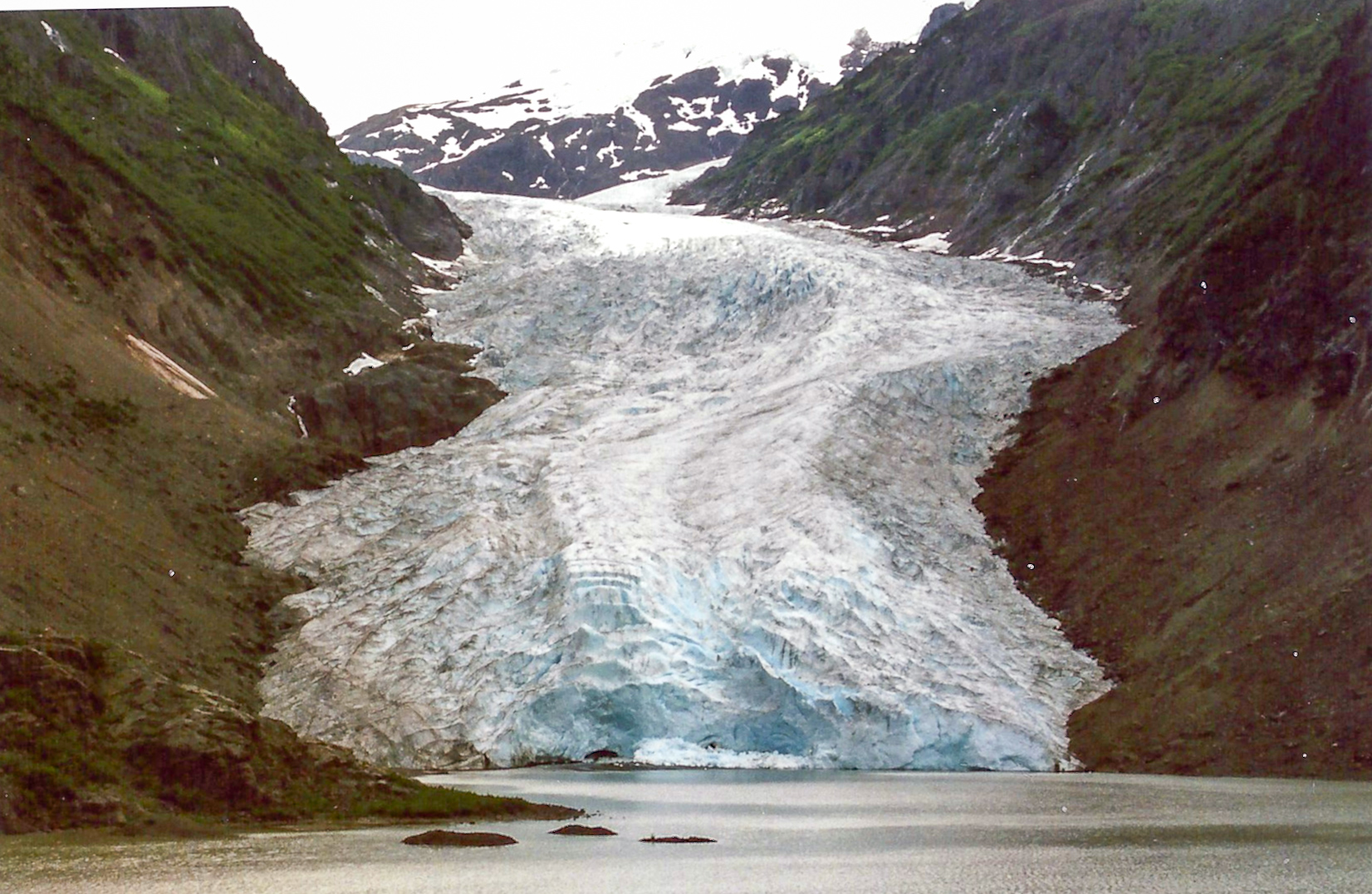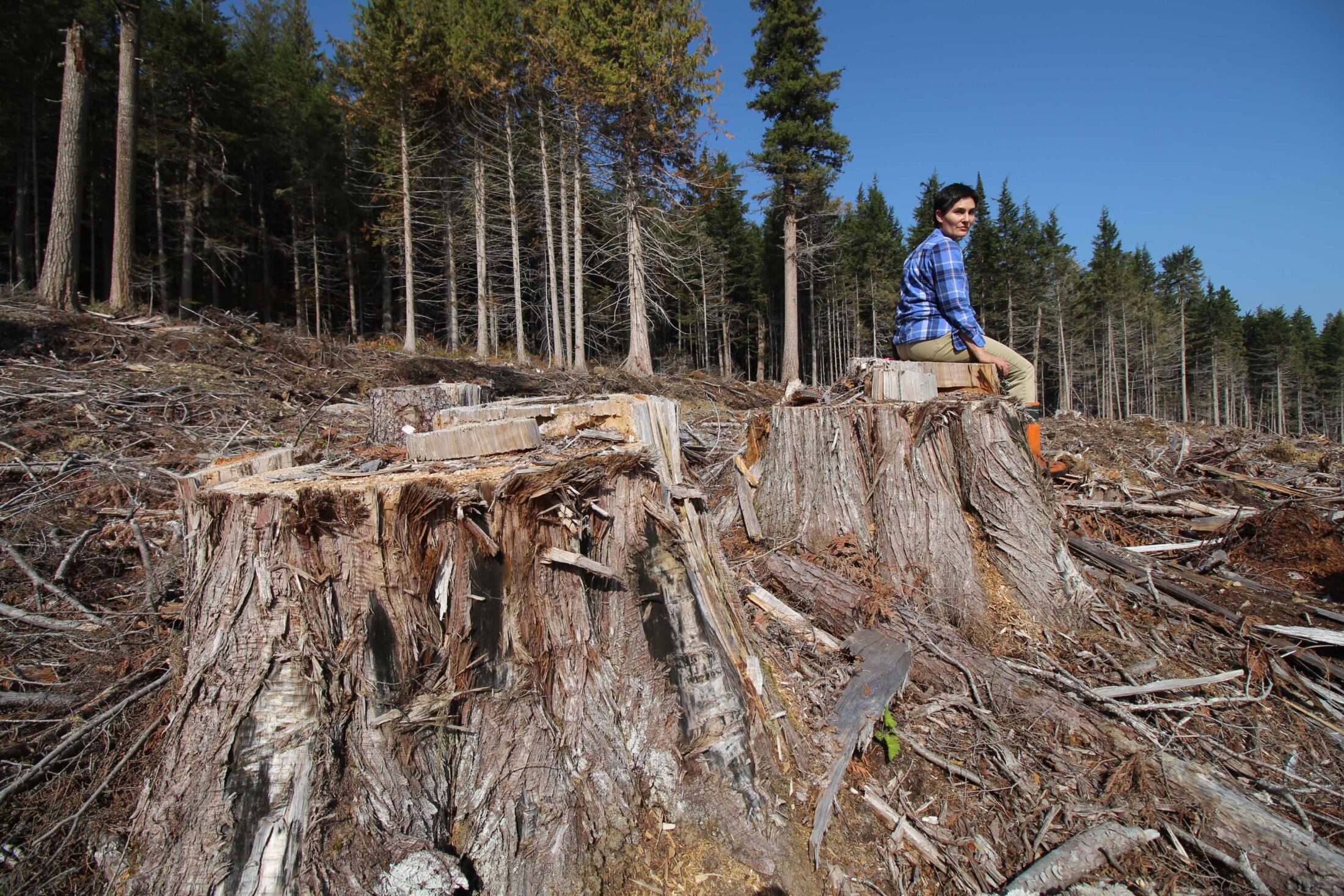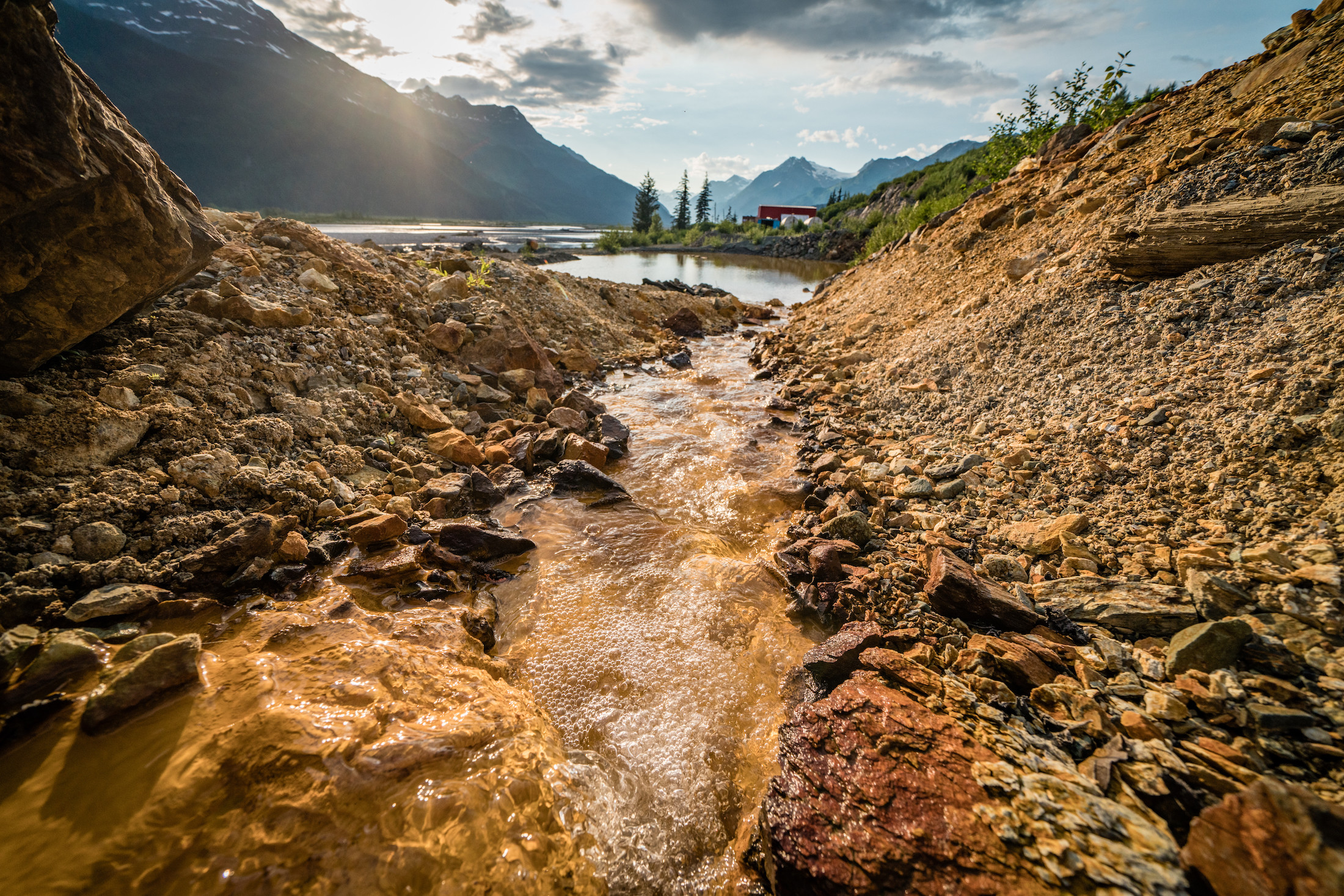
86 per cent of a river gone: First Nation calls on BC Hydro to let more water through
Katzie First Nation wants BC Hydro to let more water into the Fraser region's Alouette...
As Coastal GasLink workers prepared for test drilling under the Wedzin Kwa river in northwest B.C. while salmon were spawning last week, Wet’suwet’en land defenders gathered in the area to show their opposition to the controversial pipeline that is planned to transport fracked gas across the province to be shipped to Asia.
The workers read the land defenders the B.C. Supreme Court injunction that prohibits them from stopping work along the pipeline right of way. In response, the land defenders re-served the workers with an eviction notice from the Wet’suwet’en Hereditary Chiefs. The RCMP were called to the site, but no arrests were made.
At a rally in Smithers in support of the land defenders, Gidimt’en camp media coordinator Jennifer Wickham fought back tears as she said the whole province should know and care about the Coastal GasLink pipeline, which threatens the health of plants, animals and humans.
“It’s just a … devastating time for us right now,” she said.
The confrontation put the key election issue in northwest B.C. into sharp focus: how to balance industrial development and environmental protection while respecting Indigenous Rights. The Narwhal spoke with four of the region’s conservation leaders about that balance and the key issues northwest candidates face this election.
The majority of candidates in Northwest B.C.’s ridings — North Coast, Skeena, Stikine and Nechako — either declined interview requests or did not reply by publication time. The ridings are primarily contested by NDP and Liberal candidates and there are no Green candidates.
Over the past century, temperatures have increased about 1 C globally, 2 C in B.C. and 3 C in northern B.C., according to a B.C. government research climatologist. As northern landscapes lose snowpack and glacier cover, the exposed land absorbs more solar energy, amplifying the effects of the changes. The Intergovernmental Panel on Climate Change warns we need to stay below 1.5 C warming above pre-industrial levels to reduce impacts on ecosystems and human health.
SkeenaWild Conservation Trust executive director Greg Knox said climate change should be the top priority for any politician hoping to represent the region.
“It’s already here and impacting our fish and our water and our glaciers and our forests,” he said in an interview. “We have fewer salmon coming back due to climate impacts on the ocean and there are more floods and droughts in river systems. We see disease outbreaks in our forests and forest fires are increasing.”

The Bear Glacier near Stewart, B.C., is one of many in northwest B.C. that are retreating. Photo: phoca2004 / Flickr
Given the impacts of climate change, Knox said local politicians need to explore how to reduce other pressures on the landscape.
“They should be talking about how they’re going to improve resource extraction, like mining and forestry and development, in the face of climate change,” he said. “They have to be reducing the pressures on the landscape and they need to be putting forward ideas and election platforms that reflect that.”
Where the parties stand on climate: The NDP, BC Liberals and Greens agree greenhouse gases must be reduced to address climate change. The NDP has promised to reach net-zero emissions by 2050, while the Greens have committed to net-zero by 2045. The BC Liberals’ platform doesn’t include reduction targets.
The forestry industry represents about one in five jobs in northwest B.C. Logging trucks hauling trees to mills in places like Smithers and Houston are ubiquitous on the highways and back roads.
The province says the forestry industry will help it achieve its goal of net-zero emissions by 2050, based on the claim that logging is carbon neutral because new trees are planted to replace those that are cut down. But Shannon McPhail, director of Skeena Watershed Conservation Coalition, said there are a lot of holes in the government narrative and logging in the region is unsustainable.
“We’re gonna take out this old growth tree or this massive forest and we’re gonna replant it with things the size of a pencil and think that that’s going to suck up carbon?” she said. “What a hunk of malarkey! The return on carbon investment is a couple of generations away, especially when you recognize that a massive amount of carbon isn’t stored in the wood, it’s stored in the soil. And when you log it or cut it, you release that carbon.”
She said the logging industry is being overlooked in B.C.’s climate plan and, despite what the government says, “forestry is the biggest emitter of greenhouse gases in B.C.”
According to a 2019 Sierra Club report, logging in B.C. is responsible for around 42 million tonnes of carbon emissions every year. These emissions are not counted in the province’s inventory.
In 2018, B.C. reported a total of 67.9 million tonnes, with oil, gas and mining emitting around 10 million tonnes — about a quarter of what forestry emits, according to the Sierra Club report. The report also said clearcutting forests removes trees that would suck up 26.5 million tonnes of carbon from the atmosphere every year.

Conservation North director and ecologist Michelle Connolly sits in front of B.C.’s rare inland rainforest, which it set to be logged for pellets this winter. Photo: Sean O’Rourke
On top of that, slash burning — burning piles of unwanted or unusable wood in cutblocks, purportedly to reduce the risk of wildfires — emits around four million tonnes of carbon emissions annually, according to a Sierra Club analysis of provincial data.
In 2017, the NDP government promised to extend its carbon tax to include slash burning to encourage forestry companies to find alternative ways to deal with wood waste. Three years later, slash is still being burned and the carbon tax has not been applied to those emissions.
According to McPhail, many of the logs being burned are in fact good quality wood that could be used for lumber, pulp or pellet production.
“So much of that wood is completely usable,” McPhail said. “It’s just not fetching very nice prices right now. These beautiful, gorgeous logs — that you can’t even buck up for firewood because that’s illegal — are getting burned in these massive slash piles.”
The province is funding projects that turn wood waste into pellets, which are burned for fuel overseas, but it is also permitting companies to log old-growth forests for pellet production.
McPhail — who facilitates a group called Talkin’ Logging that brings together loggers, farmers, civil servants, tree planters, mill owners and Gitxsan Hereditary Chiefs — said there are solutions, but they require an overhaul of the way our forests are managed.
Those solutions include government funding for small-scale operations that selectively log forests over decades and small mills that process wood that larger operations would otherwise burn or discard, McPhail said.
“Logging is going to be here for many generations to come, so why don’t we make it super-efficient, sustainable, culturally appropriate and maintain biodiversity and ecosystem integrity?”
Where the parties stand on forestry: The NDP has promised to continue investing in programs that reduce wildfire risks and allocate part of the annual allowable cut to forestry companies that create new jobs. The Green Party has committed to focusing on conservation and developing the tree planting industry, as well as transferring a portion of annual harvest allocations from major companies to First Nations and communities. The Liberals have also promised to invest in tree planting and said they would develop legislation to protect commercial forests in part by reducing the cost of production.
Northwest B.C. is home to the so-called Golden Triangle, a vast stretch of mineral-rich land. Mining is deeply embedded in the culture and economics of the region, yet outdated mining laws put the region at risk.
“While other provinces have updated their mineral staking laws to reflect rights of First Nations, land use plans, protection of watersheds and municipal drinking water, B.C.’s mining laws have seen little reform,” said Nikki Skuce, director of Northern Confluence.
“COVID-19 has created a bit of a gold rush with soaring prices while the transition to a clean energy economy will also increase demand for B.C.’s minerals and metals,” she said. (Mining products are used to make electric cars, solar arrays and efficient batteries.) “At the same time, we have yet to reform our mining laws to put the safety of communities and watersheds first from tailings waste dumps and risks like the Mount Polley disaster.”
In 2014, the Mount Polley tailings dam cracked open and 25 billion litres of contaminated materials spilled into creeks and lakes, including major spawning grounds for sockeye salmon. As The Narwhal reported earlier this year, a panel appointed to review the breach made recommendations to the province, many of which have still not been implemented.
The First Nations Energy and Mining Council said recent reforms to B.C.’s mining laws fall short in several areas, including updates to safety requirements around tailings facilities.
There are also dozens of abandoned mines across northwest B.C. some of which are leaking toxic materials into the surrounding environment. The Tulsequah Chief mine, for instance, has been leaking acid rock drainage into a salmon watershed for over 60 years. The mine was abandoned in the 1950s and subsequently went through several owners before its most recent went into receivership, potentially putting B.C. taxpayers on the hook for the cleanup costs.

Water contaminated with acid mine drainage flows into a containment pond near the Tulsequah River. Photo: Colin Arisman / The Narwhal
As The Narwhal reported in August, the reclamation and final closure of the mine is projected to cost at least $48.7 million and cost an additional $1 million per year for monitoring and maintenance.
Mining companies are required to pay the province money up front to cover the costs of reclamation and closure in case they go bankrupt. But according to a 2018 report from B.C.’s chief inspector of mines, the province is running a deficit of about $1.2 billion to cover reclamation costs. More than 30 mining advocacy and law organizations have lobbied the government for years to change its laws and hold mining companies financially accountable.
“Where are the political parties at in terms of making sure the polluter actually pays?” Skuce asked. “[We need] financial assurances for the mining sector and maybe an industry fund for disasters or bankruptcy.”
Not only that, anyone with a computer and a few dollars can stake a claim. In the northwest, nearly 37,000 square kilometres are staked for mineral exploration. That’s over 11 per cent of the region’s landscape.
Where the parties stand on mining reforms: The NDP has said it would create a mining innovation hub to work toward stronger regulations and low-carbon approaches to mining, and has also promised to hold mining companies financially responsible for environmental clean-up if a project is abandoned. The Liberals have promised they would cut the mine permitting process time in half and improve the processes for development, permitting, inspection and remediation. The Green platform does not include mining.
The push to export B.C.’s natural gas reserves is dividing the northwest figuratively and literally as the Coastal GasLink pipeline is being built through Wet’suwet’en territory and the LNG Canada terminal in Kitimat takes shape. When Wet’suwet’en Hereditary Chiefs first served Coastal GasLink the eviction notice in January, the conflict escalated as militarized RCMP enforced the injunction, arresting more than 80 land defenders.
This summer, Coastal GasLink was ordered to halt construction after failing to meet its environmental requirements around wetlands and whitebark pine, an endangered species.
At the LNG terminal on the Kitimat estuary, important salmon habitat has already been destroyed, McPhail said. Once the terminal is up and running, the impacts to the Kitimat River watershed will be profound.
“When the project is fully built out, 70,000 cubic metres of water a day will be sucked out of the Kitimat River,” she said. “That’s the equivalent of what the city of Maple Ridge uses every day, coming from our tiny little Kitimat River, which, in 2018, was in Stage 4 drought.”
The Kitimat River supports Chinook, pink, chum and coho salmon, as well as steelhead and other trout.

Premier John Horgan tours the LNG Canada site in Kitimat, B.C., in January 2020. Photo: Province of British Columbia / Flickr
Pat Moss, executive director at Northwest Institute, said provincial land use plans need to be updated to include the potential impacts of LNG projects on the landscape. Land use plans are guidance documents on resource management that inform government decision-makers of core values like recreation, wildlife and ecosystems at a landscape level. The majority of the province’s land use plans were developed in the 1990s and haven’t been revised since. In northwest B.C., that means they focus on forestry and mining and don’t take LNG into consideration.
“Nobody was thinking about oil and gas pipelines crisscrossing the region,” she said. “And then, of course, it became a huge issue with Enbridge and it’s an ongoing issue with [Coastal GasLink] and all the gazillion projects still out there on the books.”
She said most of the proposed projects will likely never see the light of day, which presents an opportunity to revise those land use plans to include the fossil fuel industry.
“If the cost of oil or gas goes up enough, then there will be the incentive to try and push forward on some of these things. In a way we have the luxury now to do some planning before that happens.”
In 2018, the province committed $16 million over three years to update its land use plans in collaboration with First Nations, an outcome of B.C. becoming the first province to officially adopt the United Nations Declaration on the Rights of Indigenous Peoples into legislation.
However, many First Nations in the northwest still struggle with poverty, food insecurity and racism and are forced to watch as irreversible environmental damage is done to their territories.
Where the platforms stand on LNG: The BC Liberals have said they would accelerate the review and approval process for LNG projects, including Indigenous-led LNG export projects. The NDP has promised to monitor the LNG Canada project to ensure it meets climate targets. The Greens have long been opposed to LNG development.
For most B.C. voters, the northwest is a long way from home, but Knox said the fate of the northwest is tied to the fate of the province.
“The rest of the province benefits off of what happens here,” he said. “If we’re not doing things sustainably, that puts the economic sustainability at risk, in addition, of course, to the environmental impacts. We’ve seen how wildfires, for example, impact everybody in the province, not just people living in rural areas. And a lot of people living in the Lower Mainland like to use the northwest for their playground, so they should care about what’s going on up here.”

Climate change is contributing to more frequent forest fires in northwest B.C. Photo: B.C. Wildfire Service
Moss agreed and said the best way forward is to engage in the political arena. “Ultimately the decision will be based on politics, rather than on science. As much as I want to see us move away from that, I think the reality, for the near future anyway, is that will continue to be the case.”
Knox said northwest B.C. in many ways represents how the province portrays itself to the world. “B.C. isn’t Beautiful B.C. unless we take care of the whole province,” he said. “The northwest is a quarter of British Columbia. If we want to maintain our image and enjoy what it offers, then we should be thinking about these things.”
Get the inside scoop on The Narwhal’s environment and climate reporting by signing up for our free newsletter. On a warm September evening nearly 15...
Continue reading
Katzie First Nation wants BC Hydro to let more water into the Fraser region's Alouette...

Premier David Eby says new legislation won’t degrade environmental protections or Indigenous Rights. Critics warn...

Between a fresh take on engagement and our new life on video, our team is...
